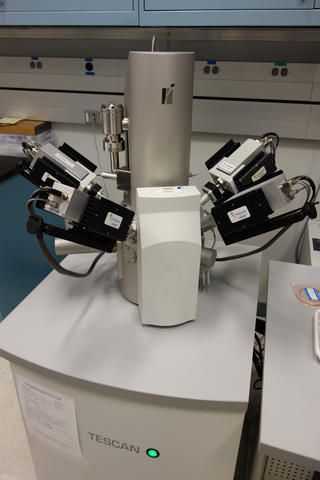TESCAN MIRA3 for automated electron microscopy

The TESCAN MIRA3’s optics column with 4 x-ray detectors.
A TESCAN MIRA3 Schottky field-emission scanning electron microscope with 4 30 mm2 silicon x-ray drift detectors which has been automated for particle and generic imaging and x-ray acquisition tasks. The microscope was optimized for high x-ray throughput (200 cps at 1 nA on Cu at 20 keV), low noise imaging and custom sizing algorithms to facilitate state-of-the-art particle analysis. The instrument is scriptable in Python using the SEMantics framework, an instrument control extension to NIST DTSA-II. On optimal samples, throughputs of 10,000 particles per hour are achievable with elemental sensitivity down to approximately 1 % for most of the periodic table.
The microscope has been used for studying environmental particles, forensics, particle size distribution characterization, standard development, large area x-ray spectrum imaging and quantitative compositional analysis. It was the first commercial SEM with 4 SDD x-ray detectors and the first instrument to acquire a spectrum image consisting of over 1 billion point spectra.
Related Publications
Ritchie, N. and Filip, V. (2011), 'SEMantics for High Speed Automated Particle Analysis by SEM/EDX', Microscopy and Microanalysis 17(S2), 896-897.
Ritchie, N. W. M. (2015), 'Diluvian Clustering: A Fast, Effective Algorithm for Clustering Compositional and Other Data', Microscopy and Microanalysis 21(5), 1173-1183.
Ritchie, N. W. M., Wight, S., Ortiz-Montalvo, D. and Lindstrom, A. P. (2023), 'Registering Particle Data Sets Using a Rotation and Translation Invariant Nearest-Neighbor Algorithm', Microscopy and Microanalysis 29(2), 512-519.
Specifications/Capabilities
Automated particle analysis, automated spectrum acquisition, automated image acquisition, automated compositional analysis.

